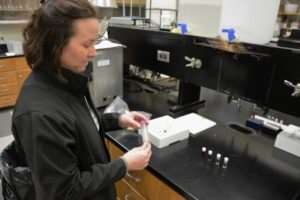The Forage and Ruminant Nutrition Lab at the Texas A&M AgriLife Research and Extension Center in Stephenville explores ways to improve ruminant diets and mitigate negative environmental impacts for researchers around the state, nation and globe, according to a Texas A&M AgriLife Research expert.

The lab is used by researchers throughout Texas, the southeastern U.S. and as far away as South Africa, Brazil and Argentina, said Dr. Jim Muir, AgriLife Research grassland ecologist, Stephenville.
The lab analyzes soils and manure to determine mineral content and forages to measure digestibility and nutritional quality of what livestock are consuming or might consume, Muir said.
Nichole Cherry, an AgriLife Research associate, is the person who makes the lab run, Muir said.
Cherry has performed more than 100,000 assays in her 13 years in the lab on samples to determine various aspects of forage and soil composition, from digestibility of forages to condensed tannin levels to identifying elements and compounds within samples.
For example, Cherry uses a machine that emulates an animal’s digestive system, Muir said. In hours it can predict digestibility that would take up to six weeks by testing animals in pastures or feedlots. The machine can analyze 50 samples in 48 hours.
“We can predict the effects and digestibility of anything the animal might ingest,” he said.
The majority of the lab’s work is on small ruminants, such as sheep and goats, which are more popular globally, and some white-tailed deer, Muir said. About 60-70 percent of samples sent in by researchers serving producers are small ruminants.
Cherry’s work with condensed tannins has put the lab on the global map because it focuses on vegetation, such as forbs and dicots, that naturally address internal parasites that can be deadly to ruminants, Muir said.
Parasites are especially rampant in tropical regions where rainfall and warm temperatures are prevalent, he said. In Texas, springtime and over-grazed pastures present parasite challenges for producers.
Muir said condensed tannins are a natural tool for producers who hope to mitigate losses to parasites.
“Condensed tannins evolved in plants as a way to protect themselves,” he said. “It usually makes them bitter and less palatable or poisonous to animals or insects, but some animals have harnessed their protective features in a co-evolutionary relationship.”
Tannins can be good and bad for animals, so the lab tries to identify ratios to help producers decide whether to increase or reduce certain browse, such as woody plants and shrubs, in diets, especially for browsers such as goats and white-tailed deer, Muir said.
Tests can determine the level of condensed tannins, where they are in the plant cell, how it is delivered and breaks down in the animal’s digestive tract, or how biologically aggressive it is in fighting gastro-intestinal parasites.
Condensed tannin assays take about two weeks, Muir said.